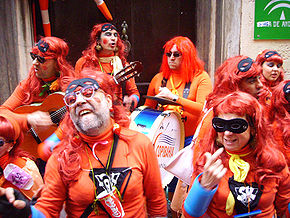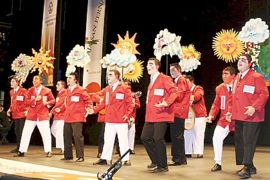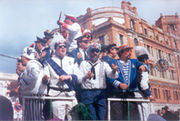
Carnival of Cádiz
Encyclopedia

Carnival
Carnaval is a festive season which occurs immediately before Lent; the main events are usually during February. Carnaval typically involves a public celebration or parade combining some elements of a circus, mask and public street party...
s in Spain. The whole city participates in the carnival for more than two weeks each year, and the presence of this fiesta is almost constant in the city because of the rehearsals, recitals, and contests held throughout the year.
The flavor of a carnival in Cádiz
It is a widely-held opinion that the city of CádizCádiz
Cadiz is a city and port in southwestern Spain. It is the capital of the homonymous province, one of eight which make up the autonomous community of Andalusia....
is blessed with the wittiest people in Spain
Spain
Spain , officially the Kingdom of Spain languages]] under the European Charter for Regional or Minority Languages. In each of these, Spain's official name is as follows:;;;;;;), is a country and member state of the European Union located in southwestern Europe on the Iberian Peninsula...
, so it is not surprising that the main characteristics of the carnival in Cádiz are the acerbic criticisms, the droll plays on words
Word play
Word play or wordplay is a literary technique in which the words that are used become the main subject of the work, primarily for the purpose of intended effect or amusement...
, stinging sarcasm, and the irreverence of parody. While some carnivals, elsewhere in the world, stress the spectacular, the glamorous, or the scandalous in costumes, Cádiz distinguishes itself with the sheer cleverness and fertile imagination of its carnival attire. It is traditional to paint the face as a humble substitute for a mask.
It is easy to get involved in the fiesta even if one is a visitor and knows no Spanish. On Saturday, everyone wears a costume, which, many times, is related to the most polemical aspects of the news. However, the Carnival of Cádiz is most famous for the satirical groups of performers called chirigotas. Their music and their lyrics are in the center of the carnival.
Carnival groups in Cádiz

Comparsa
A comparsa is the band which plays a conga during a Latin American Carnival celebration. It consists of a large group of dancers dancing and traveling on the streets, followed by a Carrosa where the musicians play...
s.
The chirigotas are well-known witty and satiric groups that train for the whole year to sing about politics, topics in the news, and everyday circumstances, while all of the members wear identical costumes. There is an official competition in Teatro Falla, where many of them compete for a group award. Their songs are all original compositions and are full of satire and wit. Each chirigota – whether a professional group or one made up of family members, friends or colleagues – has a wide repertoire of songs. They sing in the streets and squares, at improvised venues like outdoor staircases or portals, and in established open-air tablaos (tableaux) organized by the carnival clubs.
The choirs (coros) are larger groups that travel through the streets on open flat-bed carts or wagons, singing, with a small ensemble of guitar
Guitar
The guitar is a plucked string instrument, usually played with fingers or a pick. The guitar consists of a body with a rigid neck to which the strings, generally six in number, are attached. Guitars are traditionally constructed of various woods and strung with animal gut or, more recently, with...
s and lute
Lute
Lute can refer generally to any plucked string instrument with a neck and a deep round back, or more specifically to an instrument from the family of European lutes....
s. Their characteristic composition is the "Carnival Tango", and they alternate between comical and serious repertory, with special emphasis on lyrical homages to the city and its people. The costumes are, by far, the most sophisticated and elaborate of all.
The comparsas are the serious counterparts to the chirigotas in Cádiz. Poetic lyrics and criticisms are their main ingredients. They usually tend to have a more elaborate polyphony
Polyphony
In music, polyphony is a texture consisting of two or more independent melodic voices, as opposed to music with just one voice or music with one dominant melodic voice accompanied by chords ....
, and they are easily recognized by the typical countertenor
Countertenor
A countertenor is a male singing voice whose vocal range is equivalent to that of a contralto, mezzo-soprano, or a soprano, usually through use of falsetto, or far more rarely than normal, modal voice. A pre-pubescent male who has this ability is called a treble...
voice.
Other groups can be found in the streets: the quartets (cuartetos), that, oddly, can be composed of five, four, or three members. They don't bring a guitar, only a kazoo
Kazoo
The kazoo is a wind instrument which adds a "buzzing" timbral quality to a player's voice when the player vocalizes into it. The kazoo is a type of mirliton, which is a membranophone, a device which modifies the sound of a person's voice by way of a vibrating membrane."Kazoo" was the name given by...
and two sticks, that they use to mark the rhythm. They use set-piece theater scenes (pre-written skits), improvisations, and music, and they are purely comical.
The minimalist carnival groups in Cádiz are the romanceros, perhaps the oldest, and, certainly, the most invariant carnival representation in Cádiz throughout history. A romancero is a single costumed person who brings a big easel on which posters help him to tell a story with images. The romancero recites humorous verses while pointing at aspects of the pictures and drawings with a long stick.

Musical forms
Specific musical forms have evolved at the Carnival of Cádiz over the years. In the beginning, popular music was used, and tropical rhythms were mixed with popular European dances and songs; only the lyrics changed. Near the end of the nineteenth century, the musical identity of the Carnival was already mature, and, although most of the names (tangoTango music
Tango is a style of ballroom dance music in 2/4 or 4/4 time that originated among European immigrant populations of Argentina and Uruguay . It is traditionally played by a sextet, known as the orquesta típica, which includes two violins, piano, double bass, and two bandoneons...
, pasodoble
Pasodoble
Pasodoble is a typical dance from Spain march-like musical style as well as the corresponding dance style danced by a couple. It is the type of music typically played in bullfights during the bullfighters' entrance to the ring or during the passes just before the kill...
, couplet, etc.) are shared with other musical forms around the world, their melodies, rhythms, and character are unmistakably original.
- The Presentation is the first piece sung to present the characterisation of the group, called its tipo. The style of the music is absolutely free and unstructured. It can take the form of a well-known form, an original composition, or even a spoken-word recitation.
- The Couplet is sung by the chirigotas, comparsas, choirs, and quartets. They are short satirical songs with a refrain that is always related to the costume and the characterisation (tipo) of the group.
- The Pasodoble is a longer song without a refrain, and it is usually (but not always) serious, criticising something that happened during the previous year or rendering an homage to someone. They are sung by the comparsas and the chirigotas.

- The Tango, with its characteristic gaditano rhythm is sung only by the choirs, accompanied by their orchestras, and they are mostly poetical compositions.
- The Potpourri, sung by all of the groups, changing the lyrics of well-known songs of the year or any other kind of music, sometimes depending on the group's tipo.
Beside these, other musical forms, including short improvisations and theatrical skits are featured, mostly by the so-called illegal chirigotas, murgas, or callejeras, that don't submit to any rule or contest. They just roam the streets singing and performing as they wish.
The contests
The best known contest among chirigotas, choirs, comparsas, and quartets in Cádiz is the 'Official Contest' at the Gran Teatro Falla, that finishes just before the first Saturday of Carnival. It is broadcast by the regional television and radio stations. Other contests take place before, during, and after the Carnival, usually organized by institutions and private clubs, and their venues are open tablaos in the public squares (plazas) of the city.External links
- An online image archive about the history of the Carnival of Cádiz.http://www.elbaratillodelcarnaval.com/
- Guitar scores, videos and audio files of the Carnival.
- Carnival of Cadiz in Tertulia Andaluza

